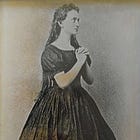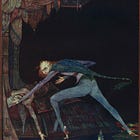A spooky doll, a mysterious palace...
In Vernon Lee's unnerving story, a woman, guided by a man called Orestes, turns up at an old Italian palace, looking to acquire some of its famed antiques....
From ‘The Doll’ by Vernon Lee
The palace was very grand. There was a ballroom as big as a church, and a number of reception rooms, with dirty floors and eighteenth-century furniture, all tarnished and tattered, and a gala room, all yellow satin and gold, where some emperor had slept; and there were horrible racks of faded photographs on the walls, and twopenny screens, and Berlin wool cushions, attesting the existence of more modern occupants.
I let the old woman unbar one painted and gilded shutter after another, and open window after window, each filled with little greenish panes of glass, and followed her about passively, quite happy, because I was wandering among the ghosts of dead people. “There is the library at the end here,” said the old woman, “if the signora does not mind passing through my room and the ironing-room; it’s quicker than going back by the big hall.” I nodded, and prepared to pass as quickly as possible through an untidy-looking servants’ room, when I suddenly stepped back. There was a woman in 1820 costume seated opposite, quite motionless. It was a huge doll. She had a sort of Canova classic face, like the pictures of Mme. Pasta and Lady Blessington. She sat with her hands folded on her lap and stared fixedly.

“It is the first wife of the Count’s grandfather,” said the old woman. “We took her out of her closet this morning to give her a little dusting.”
The Doll was dressed to the utmost detail. She had on open-work silk stockings, with sandal shoes, and long silk embroidered mittens. The hair was merely painted, in flat bands narrowing the forehead to a triangle. There was a big hole in the back of her head, showing it was cardboard.
“Ah,” said Orestes, musingly, “the image of the beautiful countess! I had forgotten all about it. I haven’t seen it since I was a lad,” and he wiped some cobweb off the folded hands with his red handkerchief, infinitely gently. “She used still to be kept in her own boudoir.”
“That was before my time,” answered the housekeeper. “I’ve always seen her in the wardrobe, and I’ve been here thirty years. Will they care to see the old Count’s collection of medals?”
Orestes was very pensive as he accompanied me home.
“That was a very beautiful lady,” he said shyly, as we came within sight of my inn; “I mean the first wife of the grandfather of the present Count. She died after they had been married a couple of years. The old count, they say, went half crazy. He had the Doll made from a picture, and kept it in the poor lady’s room, and spent several hours in it every day with her. But he ended by marrying a woman he had in the house, a laundress, by whom he had had a daughter.”
“What a curious story!” I said, and thought no more about it.
But the Doll returned to my thoughts, she and her folded hands, and wide open eyes, and the fact of her husband’s having ended by marrying the laundress. And next day, when we returned to the palace to see the complete set of old Chinese plates, I suddenly experienced an odd wish to see the Doll once more.
What we love about this excerpt….
There is the constant feeling that the meticulous bargain-hunter is about to, well, get more than she bargains for. She finally does, in the form of the lifelike doll based on the Count’s former wife. Indeed, we are told later that the doll has been made with her actual human hair.
The doll is uncanny, a lifeless imitation, and it also seems to serve as a warning to the narrator herself. Dolls—as Henrik Ibsen’s play A Doll’s House explored in this period—could symbolize the home-bound restrictions of women in conventional marriages.
We love the creepy details Lee gives about the doll, especially the ‘big hole in the back of her head.’
About the author
Violet Piaget (1856-1935), known as Vernon Lee, was an accomplished polymath, writing on science, art, music, and literature, as well as publishing her own novels and short stories. A substantial part of her life was spent in Florence, where she entertained some of the greatest writers of the late-nineteenth and early-twentieth centuries, including Henry James and Edith Wharton.
To read alongside...
Thomas Hardy’s short story ‘Barbara of the House of Grebe’ (1890) makes for an exciting companion piece to Lee’s tale. Barbara is married to a wealthy landowner but is still in love with her handsome first husband Edmond, who died a few years before. Every night, she secretly caresses a full-size sculpture of Edmond that she keeps locked away, but her husband discovers her and drags the statue out into the bedroom where he forces her to gaze at it. Eventually, she has a seizure and begs him to destroy it. She becomes a docile wife but her soul has been extinguished. This is a delightfully over-the-top tale and a side of Hardy we don’t often see in his longer works.
A similarly dramatic and grotesquely Gothic tale of a life-size work of art is Oscar Wilde’s The Picture of Dorian Gray. Like Lee’s uncanny doll, the portrait seems to speak to the viewer and to read their sins.
Finally, as in Charlotte Brontë’s Jane Eyre (1847), Lee’s story updates the folktale of Bluebeard, a powerful man who exerts complete control over his former wives by locking their dead bodies in a room that he forbids his wife to enter. Brontë uses the Bluebeard myth as a springboard to explore female agency (see our newsletter below), as does Margaret Atwood in her short story ‘Bluebeard’s Egg.’ Robert Browning’s poem, ‘Porphyria’s Lover,’ (1842), which also featured in a past LitHits newsletter (see below), likewise plays on the theme of an obsessed and disturbed lover.
The Gothic trope of the locked, forbidden, and secret room can be found across most of these works. Would you dare to open it?
Suggest a LitHit!
Tell us your own favourites from literature you've read, and become a Guest Curator. Just email us with the following information:
Your full name (and whether you want to be named or be anonymous in the newsletter—either option is fine!)
The title of the book you're suggesting
The location of the excerpt within the book (e.g., "in the middle of chapter 5"), or the excerpt itself copied into the email or attached to it (in Word)
Why you love it, in just a few sentences
**Please note that we welcome all suggestions but at the moment we can only release excerpts that are out of copyright and in the public domain. This means 75 years or more since the author's death. You can find many such out-of-copyright texts on the internet, for example at Project Gutenberg and Standard Ebooks.
About LitHits
You might also enjoy...
Writers Make Worlds: https://writersmakeworlds.com/
The Ten Minute Book Club: https://www.english.ox.ac.uk/ten-minute-book-club
Project Gutenberg: https://www.gutenberg.org/
Standard Ebooks: https://standardebooks.org/
The Poetry Foundation: https://www.poetryfoundation.org/
“Five Tips to Get Reading Again if You’ve Struggled During the Pandemic,” The Conversation (8 January 2021): https://theconversation.com/five-tips-to-get-reading-again-if-youve-struggled-during-the-pandemic-152904
Feedback
We'd love to hear your thoughts on our newsletter:
kshepherdb@yahoo.co.uk
Graphic design by Sara Azmy
All curation content © 2025 LitHits. All rights reserved.





